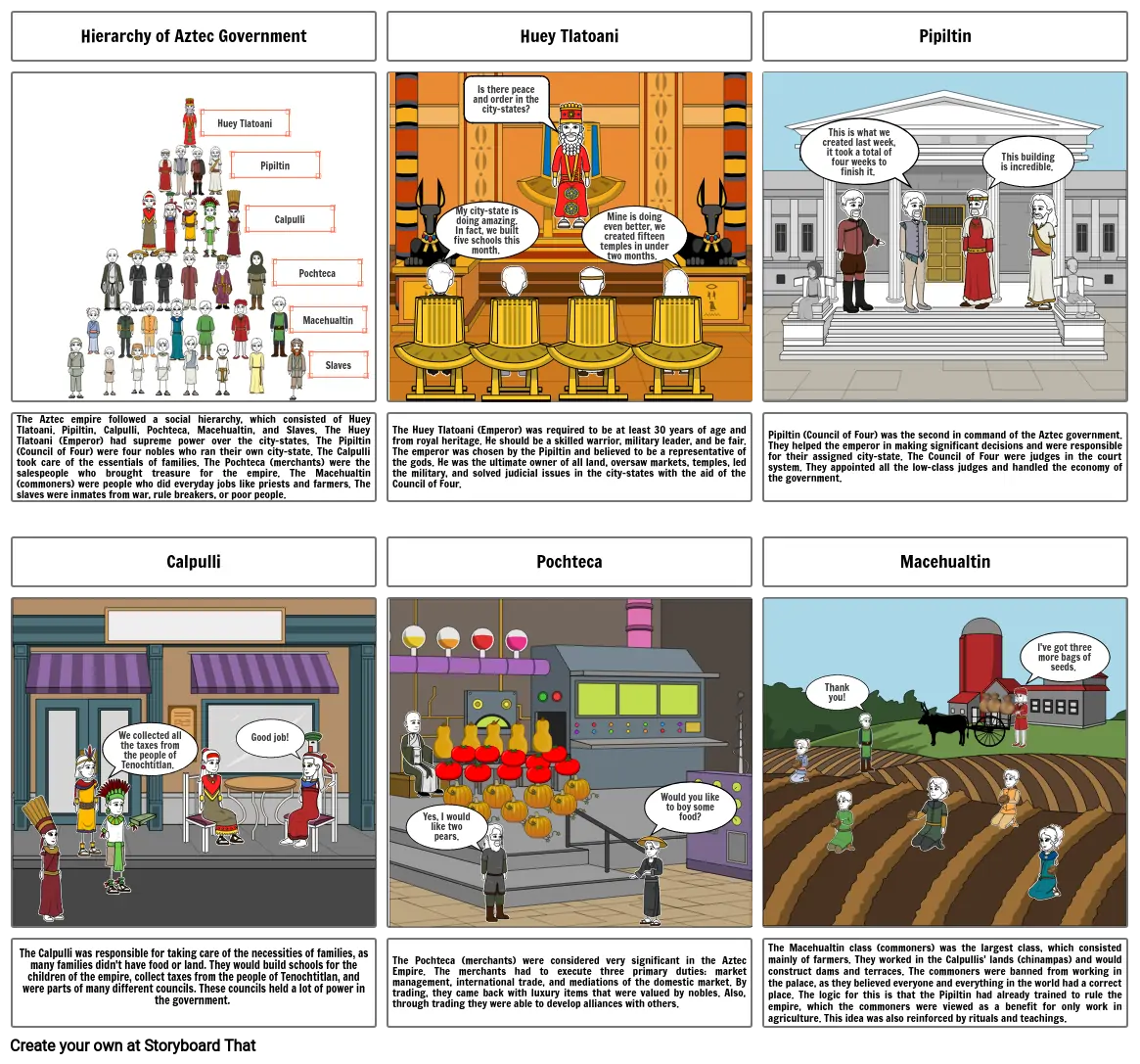Aztec Culture Comic Strip

Texto del Guión Gráfico
- Hierarchy of Aztec Government
- Huey Tlatoani
- Pipiltin
- Calpulli
- Pochteca
- Macehualtin
- Huey Tlatoani
- My city-state is doing amazing. In fact, we built five schools this month.
- Is there peace and order in the city-states?
- Mine is doing even better, we created fifteen temples in under two months.
- Pipiltin
- This is what we created last week, it took a total of four weeks to finish it.
- This building is incredible.
- The Aztec empire followed a social hierarchy, which consisted of Huey Tlatoani. Pipiltin, Calpulli, Pochteca, Macehualtin, and Slaves. The Huey Tlatoani (Emperor) had supreme power over the city-states. The Pipiltin (Council of Four) were four nobles who ran their own city-state. The Calpulli took care of the essentials of families. The Pochteca (merchants) were the salespeople who brought treasure for the empire. The Macehualtin (commoners) were people who did everyday jobs like priests and farmers. The slaves were inmates from war, rule breakers, or poor people.
- Calpulli
- Slaves
- The Huey Tlatoani (Emperor) was required to be at least 30 years of age and from royal heritage. He should be a skilled warrior, military leader, and be fair. The emperor was chosen by the Pipiltin and believed to be a representative of the gods. He was the ultimate owner of all land, oversaw markets, temples, led the military, and solved judicial issues in the city-states with the aid of the Council of Four.
- Pochteca
- Pipiltin (Council of Four) was the second in command of the Aztec government. They helped the emperor in making significant decisions and were responsible for their assigned city-state. The Council of Four were judges in the court system. They appointed all the low-class judges and handled the economy of the government.
- Macehualtin
- Thank you!
- I've got three more bags of seeds.
- The Calpulli was responsible for taking care of the necessities of families, as many families didn't have food or land. They would build schools for the children of the empire, collect taxes from the people of Tenochtitlan, and were parts of many different councils. These councils held a lot of power in the government.
- We collected all the taxes from the people of Tenochtitlan.
- Good job!
- The Pochteca (merchants) were considered very significant in the Aztec Empire. The merchants had to execute three primary duties: market management, international trade, and mediations of the domestic market. By trading, they came back with luxury items that were valued by nobles. Also, through trading they were able to develop alliances with others.
- Yes, I would like two pears.
- Would you like to boy some food?
- The Macehualtin class (commoners) was the largest class, which consisted mainly of farmers. They worked in the Calpullis' lands (chinampas) and would construct dams and terraces. The commoners were banned from working in the palace, as they believed everyone and everything in the world had a correct place. The logic for this is that the Pipiltin had already trained to rule the empire, which the commoners were viewed as a benefit for only work in agriculture. This idea was also reinforced by rituals and teachings.
Más de 30 millones de guiones gráficos creados

